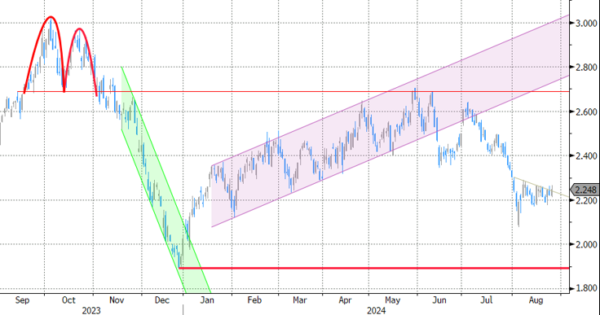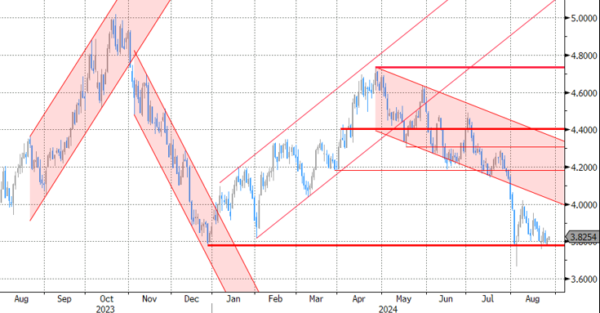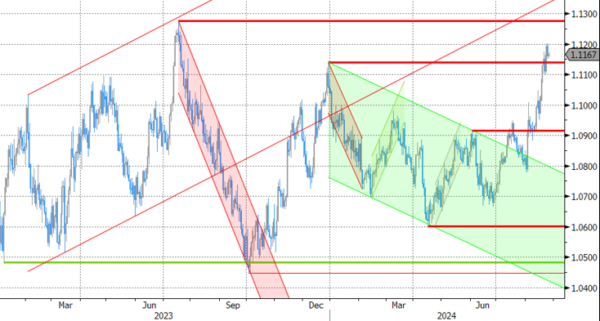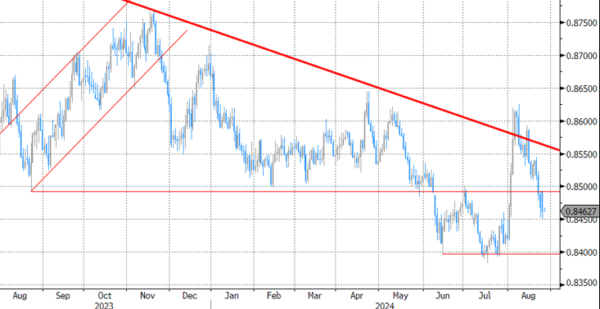Markets
Interest rate markets were looking for a new short-term equilibrium for the post-Jackson Hole era yesterday. Early in the session, yields tried to build on Friday’s decline as Fed Chair Powel officially rubberstamped the start of a genuine rate cut cycle in September while leaving all options open on the pace of easing. However, with already more than 100 bps of rate cuts discounted for the three remaining Fed meetings of this year, the lows (ex the August 5 spike) held. Unconvincing data were not able to push yields sustainably lower. German Ifo business confidence declined marginally (86.6 from 87.0), confirming last week’s poor PMI reading, but the damage could have been bigger. Headline US durable goods orders were strong (9.9%) but an upswing in Boeing orders masked a mediocre performance of core orders and shipments. In an interview with Bloomberg, San Francisco President Mary Daly repeated the Jackson Hole message from Fed Chair Powell. ‘The time to adjust policy is upon on us.’ Daly didn’t gave guidance of the pace of easing (25 bps or 50 bps). Still, she clearly indicated that the Fed wants to avoid restrictive policy to unnecessary slow growth/the labour market. In case of real labour market weakness, it would be appropriate to be more aggressive. Still the comments also were no game-changer for interest rate markets. At the end of the day, US yields even rose modestly between 2 bps (2-y) and 1.4 bps (30-y). A mild rise in inflation expectations due to higher oil prices (Brent oil jumping to $81+ p/b) probably was also in play. German yields added between 3.0 bps (5-y) and 1.3 bps (30-y). The dollar decline slowed (close DXY 100.85, EUR/USD 1.1161, USD/JPY 144.53) but intraday ‘gains’ were technically irrelevant. Equities ran into resistance as the S&P 500 came within reach of the all-time record (S&P -0.32%, Nasdaq -0.85%).
Asian markets this morning join yesterday’s momentum in the US with equities mostly showing modest declines (Japan being an exception). US yields are rising marginally. The dollar trades little changed (DXY 110.84, EUR/USD 1.1168). Later today, German GFK consumer confidence, US house price data and US consumer confidence (Conference Board) have intraday market moving potential but probably won’t force a break of key technical levels. Also keep an eye at a $69 bln 2-y sale of US Treasury notes after the recent sharp decline in yields. For now we expect technical support levels in yields to hold with next reality check to be provided by the key US early month data next week (ISM’s, payrolls). Expectations for a further easing of US/global financial conditions will probably keep the dollar in a sell-on-upticks pattern.
News & Views
UK shop prices were flat in M/M-terms but fell by 0.3% Y/Y in August (from +0.2% Y/Y in July) in their first Y/Y-decline since end 2021. Non-food prices dropped for a third month running (-0.1% M/M) with their Y/Y-price fall accelerating from 0.9% to 1.5%. Food prices rose by 0.2% M/M and 2% Y/Y. Fresh food price inflation eased from 1.4% Y/Y to 1% Y/Y. The British Retail Consortium commented that retailers discounted heavily (non-food) to shift their summer stock, particularly for fashion and household goods. This discounting followed a difficult summer of trading caused by poor weather and the continued cost of living crunch impacting many families. Looking ahead, the BRC warned for renewed inflationary pressures because of an uncertain outlook for commodity prices (impact climate change on harvests & rising geopolitical tensions).
French President Macron yesterday rejected the left-wing New Popular Front’s (winner of parliamentary election) candidate for new prime minister, Lucie Castets. “The institutional stability of our country requires us not to choose the NFP option”. Macron remains convinced that he can put together a coalition involving moderate politicians from center-left and center-right. PM Attal and his caretaker government remain in place for now with the clock is ticking with a 2025 budget vote scheduled in October.
Graphs
GE 10y yield
The ECB cut policy rates by 25 bps in June. Stubborn inflation (core, services) make follow-up moves less evident. Markets nevertheless price in two to three more cuts for 2024 as disappointing US and unconvincing EMU activity data rolled in, dragging the long end of the curve down. The move accelerated during the early August market meltdown.
US 10y yield
The Fed in its July meeting paved the way for a first cut in September. It turned attentive to risks to the both sides of its dual mandate as the economy is moving to a better in to balance. Markets tend to err in favour of a 50 bps lift-off. The pivot weakened the technical picture in US yields with another batch of weak eco data pushing the 10-yr sub 4%. Powell at Jackson Hole didn’t challenge markets’ positioning.
EUR/USD
EUR/USD moved above the 1.09 resistance area as the dollar lost interest rate support at stealth pace. US recession risks and bets on fast and large (50 bps) rate cuts trumped traditional safe haven flows into USD. EUR/USD 1 1.1276 (2023 top) serves as next technical reference.
EUR/GBP
The BoE delivered a hawkish cut in August. Policy restrictiveness will be further unwound gradually on a pace determined by a broad range of data. The strategy similar to the ECB’s balances out EUR/GBP in a monetary perspective. Risk-off proved a more important driver of GBP recently, triggering a brief return from 0.84 towards 0.86.

















